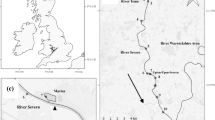Abstract
Vertical distributions and nocturnal migrations of the developmental stages of Nyctiphanes couchi (Bell) in relation to the summer thermocline in the Celtic Sea, 25 to 26 August 1982, have been investigated using the Longhurst-Hardy Plankton Recorder (LHPR). The vertical distributions of the metanauplii and adult females suggest that N. couchi liberates its young within the euphotic zone as mature metanauplii which, in a matter of hours, moult into the first feeding stage (Calyptopis I). The ascent migration by adult females took a maximum of 3 h (17.10 to 20.05 hrs) and had an amplitude of ∼50m (54 to 4 m) from below to above the thermocline. A ∼7C° thermocline occurred between 20 to 30 m in these profiles. The nocturnal migrations by the females were for the purpose of breeding as well as feeding within the euphotic zone and were not influenced by the presence of the thermocline. The majority of the calyptopes and furciliae remained above the thermocline over the sampling period. The post-larval males and females migrated; their vertical distributions showed a pattern similar to those of the adult females. The larger the developmental stage, the deeper was the mode of its vertical distribution. The zooplankton dry weight in the profiles ranged from 3.74 to 6.91 g per haul (=1.85 to 3.45 g C m-2, 0 to 100 m). The euphausiids represented ∼35% of total zooplankton dry weight and their migrations removed a large percentage of the total zooplankton biomass from the euphotic zone for ∼18 h d-1. Such a large displacement of biomass would have a major impact on the biological interactions within the ecosystem.
Similar content being viewed by others
Literature cited
Boden, B. P.: The egg and larval stages of Nyctiphanes simplex, a euphausiid crustacean from California. Proc. zool. Soc. Lond. 121, 515–527 (1951)
Boyd, C. M., M. Heyraud and C. N. Boyd: Feeding of the Antarctic krill Euphausia superba. J. Crustacean Biol. (Lawrence, Kansas) 4 (Spec. No. 1), 123–141 (1984)
Einarsson, H.: Euphausiacea. I. Northern Atlantic species. Dana Rep. 27, 1–185 (1945)
Fronst, W. E.: Observations on the reproduction of Nyctiphanes couchi and Meganyctiphanes norvegica (Sars) off the south coast of Ireland. Proc. R. Ir. Acad. (Ser. B) 40, 194–232 (1932)
Glover, R. S.: The continuous plankton recorder survey of the North Atlantic. Symp. zool. Soc. Lond. 19, 189–210 (1967)
Hickling, C. F.: Notes on euphausiids. J. mar. biol. Ass. U.K. 13, 735–745 (1925)
Joint, I. R. and R. K. Pipe: An electron microscope study of a natural population of picoplankton from the Celtic Sea. Mar. Ecol. Prog. Ser. 20, 113–118 (1984)
Joint, I. R. and A. J. Pomroy: Production of picoplankton and small nanoplankton in the Celtic Sea. Mar. Biol. 77, 19–27 (1983)
Joint, I. R. and R. Williams: Demands of the herbivore community on phytoplankton production in the Celtic Sea in August. Mar. Biol. 87, 297–306 (1985)
Lasker, R.: Feeding, growth, respiration and carbon utilisation of a euphausiid crustacean. J. Fish. Res. Bd Can. 23, 1291–1317 (1966)
Lebour, M. V.: The Euphausiidae in the neighbourhood of Plymouth and their importance as herring food. J. mar. biol. Ass. U.K. 13, 402–431 (1924)
Lindley, J. A.: Continuous plankton records: the distribution of the Euphausiacea (Crustacea: Malacostraca) in the north Atlantic and North Sea, 1966–67. J. Biogeogr. 4, 121–123 (1977)
Lindley, J. A.: Continuous plankton records: geographical variations in numerical abundance, biomass and production of euphausiids in the North Atlantic Ocean and the North Sea. Mar. Biol. 71, 7–10 (1982)
Mauchline, J. and L. R. Fisher: The biology of euphausiids. Adv. mar. Biol. 7, 1–454 (1969)
Morris, D. J.: Filtration rates of Euphausia superba Dana: under and overestimates. J. Crustacean Biol. (Lawrence, Kansas) 4 (Spec. No. 1), 185–197 (1984)
Nicol, S.: Cod end feeding by the euphausiid Meganyctiphanes norvegica. Mar. Biol. 80, 29–33 (1984)
Russell, F. S.: The vertical distribution of marine macroplankton. IV. Further observations on diurnal changes. J. mar. biol. Ass. U.K. 51, 81–103 (1928)
Williams, R.: Vertical distribution of Calanus finmarchicus and C. helgolandicus in relation to the development of the seasonal thermocline in the Celtic Sea. Mar. Biol. 86, 145–149 (1985)
Williams, R., N. R. Collins and D. V. P. Conway: The double LHPR system, a high speed micro- and macroplankton sampler. Deep-Sea Res. 30, 331–342 (1983)
Williams, R. and D. B. Robins: Effects of preservation on wet weight, dry weight, nitrogen and carbon contents of Calanus helgolandicus (Crustacea: Copepoda). Mar. Biol. 71, 271–281 (1982)
Author information
Authors and Affiliations
Additional information
Communicated by J. Mauchline, Oban
Rights and permissions
About this article
Cite this article
Williams, R., Fragopoulu, N. Vertical distribution and nocturnal migration of Nyctiphanes couchi (Crustacea: Euphausiacea) in relation to the summer thermocline in the Celtic Sea. Mar. Biol. 89, 257–262 (1985). https://doi.org/10.1007/BF00393659
Accepted:
Issue Date:
DOI: https://doi.org/10.1007/BF00393659




